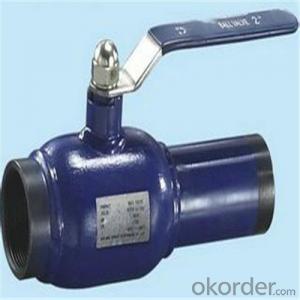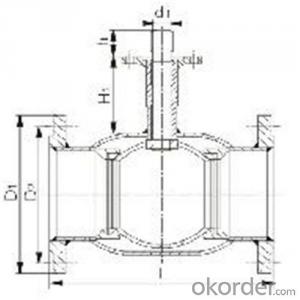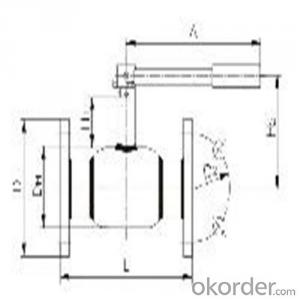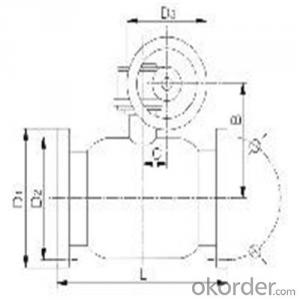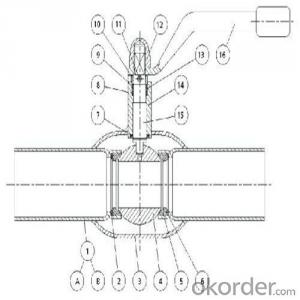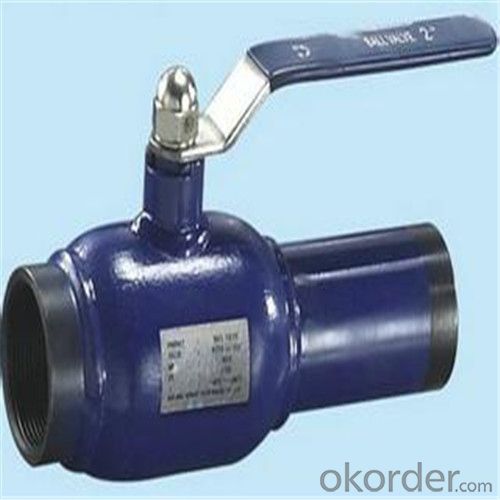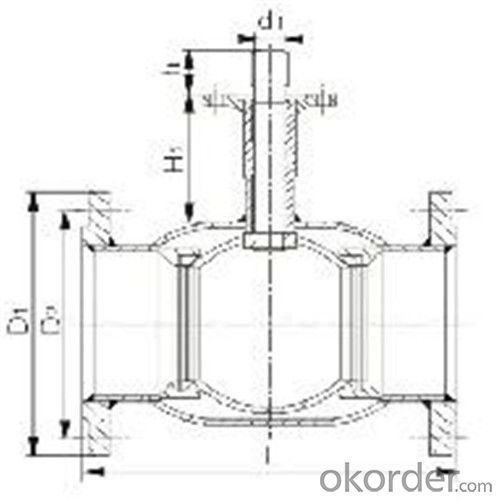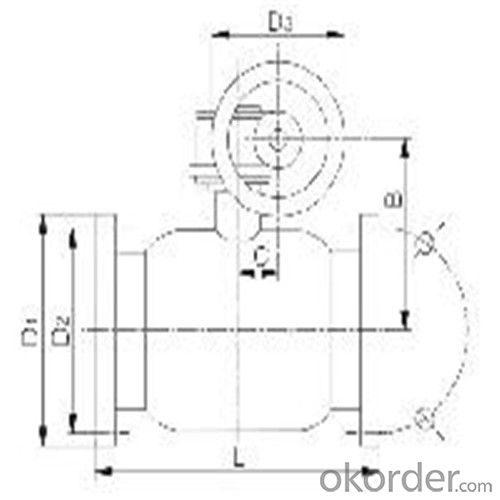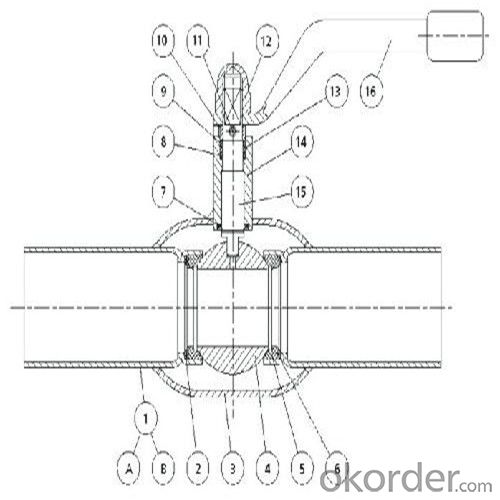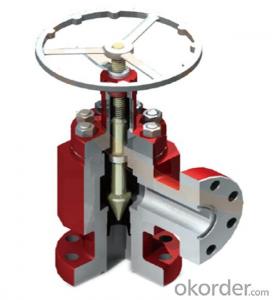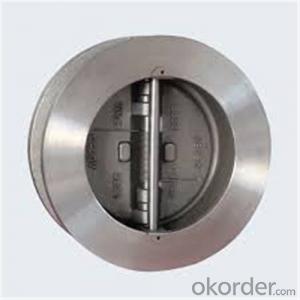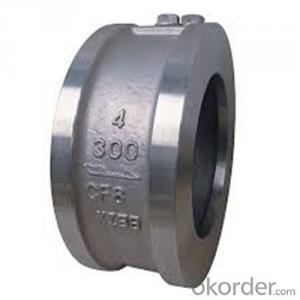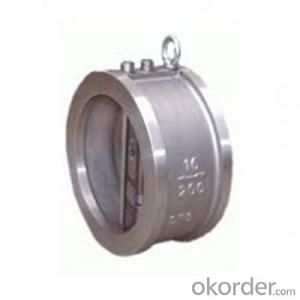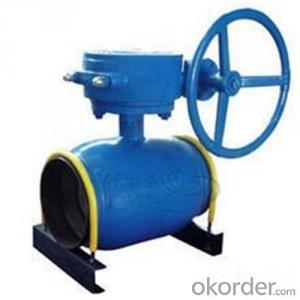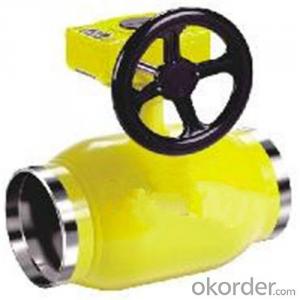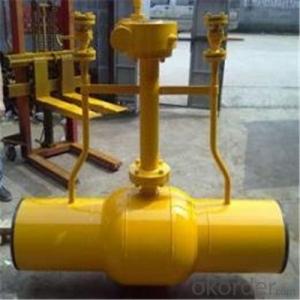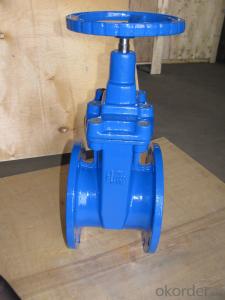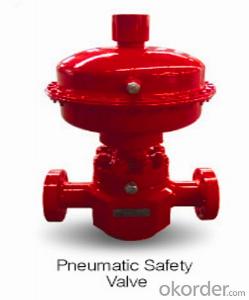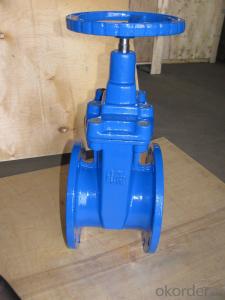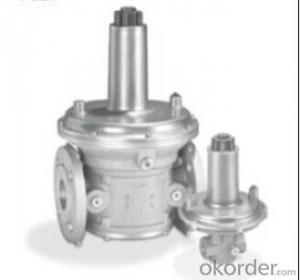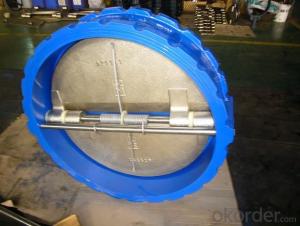Ball Valve For Heating SupplyDN 125 mm high-performance
- Loading Port:
- Shanghai
- Payment Terms:
- TT OR LC
- Min Order Qty:
- 100 pc
- Supply Capability:
- 1000 pc/month
OKorder Service Pledge
OKorder Financial Service
You Might Also Like
Ball Valve For Heating Supply
Product Description of Ball valve for heating supply:
Technical introduction
★The ball valve is designed as fully welded structure,which can prevent the leakage of medium.
★The valve seat is floating and spring-loade.The seal is made of soft seal materials of PTFE+20%C and Viton B.The seat is tightly abutted against the ball surface by the pressure of a spring,so that even if the media is in low pressure,a reliable sealing can be assured for the ball valve.Double piston effect and double seal(two-seal seat)are adopted in specially designed valve seat to realize double sealing,which makes the tightness of the ball valve more advantageous and the operation easier.
★A floating ball is adopted for DN15-DN200,and a stem and trunnion ball is adopted for DN200 and above,which can ensure the accurate position of different size ball.In other words,the sealing performance,low torque valve and operability can be guaranteed.
★The sealing of the stem is fulfilled by two replaceable O-rings and packing consisting of PTEE+20%C or flexible graphite,as the packing seal material,is fire proof effect,and is specially suitable for fuel gas systems.
★The materials used for the valve body and pipelines are the same(carbon steel or SS steel),valve body and stem adopt SS steel and the packing adopts PTEE+20%C which is corrosion-resistance or flexible graphite.
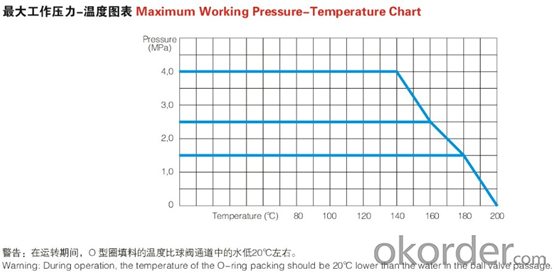
Design Features of Ball valve for heating supply:
Features and Applications
Raymond's fully welded ball valve for heating supplyand Fuel Gas systemare used to control the flow at fully open or closed position,not regulate the flow.Only special types of ball valves can realize the flow regulation.Therefore,our welded ball valves can satisfy the requirements of heating systems,e.g:
★Main pipelines of heating equipment
★Cross channels of heating pipes
★Heat exchanger station and any long distance operating station,e.g:
For the transmission of hot water and two kinds of mixed media(water,air or natural gas),limited to Max.4.0MPa and 200°C.
For the transmission of natural gas and one medium,from -30°C to 60°C,and even up to 150°C using specially designed ball valves.
★Coal gas pipelines,trunk and the branch supply lines.
Standard of Ball valve for heating supply:
Actuator | Gear Handwheel customize |
Connection | Flange SW Weld customize |
Medium | Gas Natural gas Water customize |
Medium Temperature | <200< span="">℃ customize |
Application Fields | Electricity Medical Petrochemical customize |
Connection Standard | EN 1092-1 EN 12627 ISO 7-1 customize |
FAQ of Ball valve for heating supply:
Q1:I can’t find the type of steel check valve which I need. what can I do?
The chart above only lists out some common composition of steel check valve parts.We may provide other different parts material composition according to the customer's request or the actual valve working condition.
Q2:Which certification do your products pass?
Our products are in accordance with ISO 9001、ISO 14001、API 6A、API 6D、TS CE、API607/6FA/BS6755.
Q3:How can I place an order?
The only one thing you should do is to tell us the sepecification about type 、quantity and mode of transportation, then we will send you quotation within 24 hours.
- Q: I am looking at getting a baritone horn of my own, but am not sure what compensating versus non-compensating valves are?
- It okorder /
- Q: when heater heats water there is a small leak thru the releif valve. need answrers to possible reasons for malfuntion. leak is not continous.
- Do not open the relief valve, you can scald yourself. It is leaking for 1 of 3 reasons. 1. It was opened once already the spring is weaker now, or the seat is damaged. 2. It did it's job and relieved high preasure at some point with the same affect as #1. 3. It is old and weak, either way it needs to be replaced. You do not need to drain the tank for this since it is on top, shut off the water turn it off and let it cool before you open any lines. Good luck.
- Q: Someone explained on chevy that valve guide clearance can limit lift.
- Valve guide clearance is distance between the valve stem and the valve stem guide. It is critical for proper engine operation.
- Q: The Hawker Tempest was the fastest piston powered airplane ever made, it had a sleeve valve engine. It was made obsolete, by the Me 262 and other jet engined fighters, But it's engine was the ultimate piston aircraft engine. Then piston engines became something for inexpensive planes, but why has the sleeve valve not undergone further development as a sports car engine?
- it is a good suggestion. perhaps someone would take steps to implement it.
- Q: I noticed when I pulled my pcv valve off the valve cover the entire guts were missing. what would this make the car run like?
- It would just make a bunch of oil pool up in the intake. If it was plugged it could damage seals.
- Q: also are those air flow limiting valves safe for the air pump to reduce the flow of air, I have one because the air bubbles are just way too many without one and it scares the fish away
- a check valve is to prevent back siphoning of water into the pump if you have a power outage or unplug the pump by accident. I'd suggest checking it by blowing through it the wrong way; if air does pass through get a new check valve (check new ones to be sure they don't limit airflow too much, and that the close in the wrong direction, many are cheap crap and don't work the day you buy them, so check them before you leave the store with it...note: same with thermometers, compare them with each other so you don't get the one that's crap) what you want is a normal air valve, they come in various configurations, one or more valves so as to run multiple airstones and to balance the airflow to each stone or ornament. You should not however just use the valve to limit airflow, as this damages the pump eventually. You can just let one of two valves bleed off a little air; however make sure another check valve is in the line from the tank to the valves or else you risk water coming out of that valve if it's lower than the tank water level.....You may want a smaller air pump or an adjustable one instead.
- Q: I have a Ford Explorer 4x4 2004 model.The check engine light soon has been on for two to three weeks, I finally got it checked and they said i need my ERG valve cleaned. They quoted it for around 50 bucks, which is fine. However, i dont get paid until a week from now. Will it be alright until then?What are the effects of a dirty/faulty ERG valve if not taken care of??There are not sputtering or anything abnormal that i can tell..Thanks.
- You'll be fine, drive it.
- Q: I have a 2004 yfz 450 and in the passed 4 rides (about 2 hours long each), one of my valves has stayed down and been broken when the piston came back up and made contact with it. After putting it back together the first time i checked numerous times to make sure timing, valve movement, and camshaft movement were all correct. and just 2 rides later (today) the same thing happened again. I have not began work on it yet so i do not know if it is the same valve. But has anyone ever had this problem before? Is this something frequent with yfz's or am i missing an important maintence issue? And can anyone tell me why this is happening? All help and tips are much appreciated!! Thanks!!
- Valve guides wear and get loose, so the valve stem binding up in them is highly unlikely. If the guides are shot, they should be replaceable. Sometimes valve stems warp and will cause your problem, but the odds of it happening a second time are also unlikely. Once you tear into it, I guess the deciding factor will be if it's the same valve or a different one. When this happened, were your rpm's high or otherwise? I ask because if when high, I'd check for a broken or weak valve spring/s. Most have one spring inside of another to reduce harmonic vibrations and if the inside is broken, not only will you not have adequate spring resistance for high rpm running, but at a certain rpm the remaining spring will be quivering like a dog pooping peach seeds. The other thing that may have happened is the camchain tensioner isn't locking tightly. If so, that would let the chain jump a tooth or two and then Mr. Piston and Mr. Valve get into hand to hand combat. The old 6 cylinder Kawasakis were well known for having crappy tensioners that would do just that. However, with them, it usually happened during startup. Or, you may have had a camchain guide fail and with it laying in the bottom of the oil pan,the tensioner isn't able to take up all the slack in the chain. When you get it apart, let us know what you find because I suspect you need to be looking for the cause of the bent valve somewhere else than the valve itself.
- Q: My pressure reducing valve (or restricting valve) was looked at by three master plumbers and they all said I need a new one. My water pressure has been low for weeks. It measures about 100 psi at the outside hose bibs, but it is very low inside and suddenly reduces after you turn on the facets inside. The shower is ok. My automatic sprinkler system is not able to work now due to low pressure. A relative of mine thinks we can just add a handle (as one is missing) on the valve and adjust the pressure ourselves. The repair of the valve is around $500-600! I am told in Texas that we have to have a permit and inspection to repair this valve. Also I was told by the last plumber that came out, that I have to install a expansion tank on my new hot water heater according to code. I'm not sure if that is a city code or federal. Please respond as to information you may have on this problem. The expansion tank is required I'm told when you have a pressure reducing valve for safety, is this true?
- The cost you quoted seems a bit high to me. Mine didn't cost anywhere near that amount in East Texas. A pressure reducing valve acts like a check valve when there is no flow. That is it closes as the pressure rises when you are not using any water. In this condition, the hot water heater can raise the pressure even higher since there is no place for the expanding water to go. That is the reason for the expansion tank. Without the expansion tank the pressure relief valve on the hot water heater can relieve unnecessarily or weep a bit.
- Q: I assembled my new gas grill, but I'm not sure if the burner pipes (aka venturi) are properly connected to the valves. My assembly matches the picture in the instruction manual, but I'm not sure if the seal is tight enough. How do I know? Do I attach the propane and test? I'm concerned about the safety of doing so. Thanks!
- Brush on some soapy water solution around all fittings and turn on the tank. If your not comfortable with it wait and have someone else check it out.
Send your message to us
Ball Valve For Heating SupplyDN 125 mm high-performance
- Loading Port:
- Shanghai
- Payment Terms:
- TT OR LC
- Min Order Qty:
- 100 pc
- Supply Capability:
- 1000 pc/month
OKorder Service Pledge
OKorder Financial Service
Similar products
Hot products
Hot Searches
Related keywords
